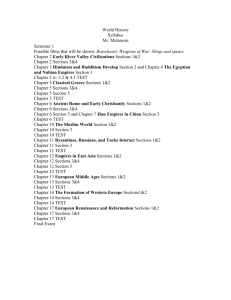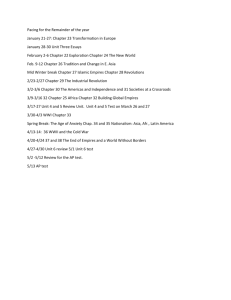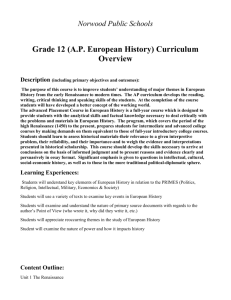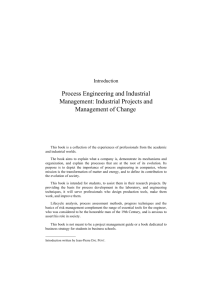enclosures
advertisement
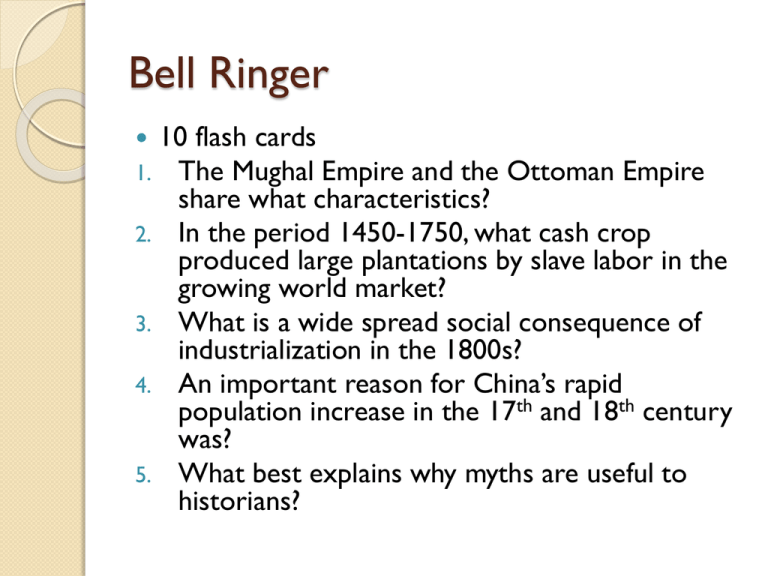
Bell Ringer 10 flash cards The Mughal Empire and the Ottoman Empire share what characteristics? 2. In the period 1450-1750, what cash crop produced large plantations by slave labor in the growing world market? 3. What is a wide spread social consequence of industrialization in the 1800s? 4. An important reason for China’s rapid population increase in the 17th and 18th century was? 5. What best explains why myths are useful to historians? 1. 6. What best describes how 19th century industrialization affected European women's lives? 7. Before 600 C.E., large centralized empires such as the Han, Persian, and Roman empires, extended their military power by… 8.The North and South American independence movements of the late 18th and early 19th centuries shared…. 9.In contrast to initial industrialization, the second Industrial Revolution in the last half of the 19th century was particularly associated with the mass production of what? 10. Most world historians would agree that the key to European predominance in the world economy during the 19th and early 20th centuries was… The Mughal Empire and the Ottoman Empire before 1700 C.E. shared which of the following characteristics? A. both empires were able to expand without meeting strong resistance. B. both empires formally restricted foreign trade. C. both empires were ruled by a single religious official. D. both empires were religiously and culturally diverse. The Mughal Empire and the Ottoman Empire before 1700 C.E. shared which of the following characteristics? A. both empires were able to expand without meeting strong resistance. B. both empires formally restricted foreign trade. C. both empires were ruled by a single religious official. D. both empires were religiously and culturally diverse. In the period 1450-1750, which of the following, produced on large plantations by slave labor, were significant commodities in the growing world market? A. grains such as wheat and barley B. tropical fruits such as bananas and oranges C. animal products such as wool and beef D. cash crops such as sugar and tobacco In the period 1450-1750, which of the following, produced on large plantations by slave labor, were significant commodities in the growing world market? A. grains such as wheat and barley B. tropical fruits such as bananas and oranges C. animal products such as wool and beef D. cash crops such as sugar and tobacco Which of the following was a widespread social consequence of industrialization in the 1800s A. a decline in the social status of women B. an increase in the power and prestige of the landowning aristocracy C. the general leveling of social hierarchies based on wealth D. the creation of a wage-earning working class concentrated in urban areas Which of the following was a widespread social consequence of industrialization in the 1800s A. a decline in the social status of women B. an increase in the power and prestige of the landowning aristocracy C. the general leveling of social hierarchies based on wealth D. the creation of a wage-earning working class concentrated in urban areas An important reason for China’s rapid population increase in the 17th and 18th centuries was… A. the introduction of new crops from the Americas B. the end of the bubonic plague in Asia C. the widespread adoption of the European three-field system D. unprecedented immigration from the Mughal and Ottoman empires. An important reason for China’s rapid population increase in the 17th and 18th centuries was… A. the introduction of new crops from the Americas B. the end of the bubonic plague in Asia C. the widespread adoption of the European three-field system D. unprecedented immigration from the Mughal and Ottoman empires. Which of the following best explains why myths are useful to historians? A. myths clarify how ancient technology worked. B. myths analyze how great heroes created the first societies. C. myths provide insights into the values and traditions of their societies. D. myths give detailed plans showing how ancient leaders achieved power. Which of the following best explains why myths are useful to historians? A. myths clarify how ancient technology worked. B. myths analyze how great heroes created the first societies. C. myths provide insights into the values and traditions of their societies. D. myths give detailed plans showing how ancient leaders achieved power. Which of the following best describes how 19th century European industrialization affected European women’s lives? A. by the end of the century, new social welfare legislation made it possible for most women to earn university degrees. B. married women found it increasingly difficult to balance wage work and family responsibilities. C. by the end of the century, women gained the right to vote in most European countries. D. women came to dominate the agricultural workforce as men moved to cities to take industrial jobs. Which of the following best describes how 19th century European industrialization affected European women’s lives? A. by the end of the century, new social welfare legislation made it possible for most women to earn university degrees. B. married women found it increasingly difficult to balance wage work and family responsibilities. C. by the end of the century, women gained the right to vote in most European countries. D. women came to dominate the agricultural workforce as men moved to cities to take industrial jobs. Before 600 C.E., large centralized empires such as the Han, Persian, and Roman empires, extended their military power by… A. giving more political power to the common people in conquered territories, thus eliminating the need for large armies of occupation. B. developing supply lines and building infrastructure, including defensive walls and roads. C. creating open societies inclusive of different religious and cultural practices, thus decreasing the chance of revolts. D. recruiting their armies entirely from inhabitants of their core territories and excluding members of newly conquered lands. Before 600 C.E., large centralized empires such as the Han, Persian, and Roman empires, extended their military power by… A. giving more political power to the common people in conquered territories, thus eliminating the need for large armies of occupation. B. developing supply lines and building infrastructure, including defensive walls and roads. C. creating open societies inclusive of different religious and cultural practices, thus decreasing the chance of revolts. D. recruiting their armies entirely from inhabitants of their core territories and excluding members of newly conquered lands. The North and South American independence movements of the late 18th and early 19th centuries shared which of the following? A. revolutionary demands based on Enlightenment political ideas. B. Reliance on Christian teachings to define revolutionary demands. C. Industrial economies that permitted both areas to break free of European control. D. Political instability caused by constant warfare among the new states. The North and South American independence movements of the late 18th and early 19th centuries shared which of the following? A. revolutionary demands based on Enlightenment political ideas. B. Reliance on Christian teachings to define revolutionary demands. C. Industrial economies that permitted both areas to break free of European control. D. Political instability caused by constant warfare among the new states. In contrast to initial industrialization, the second Industrial Revolution in the last half of the 19th century was particularly associated with the mass production of which of the following? A. textiles, iron, and coal B. textiles, automobiles, and plastics C. airplanes, ships, and radios D. electricity, steel, and chemicals In contrast to initial industrialization, the second Industrial Revolution in the last half of the 19th century was particularly associated with the mass production of which of the following? A. textiles, iron, and coal B. textiles, automobiles, and plastics C. airplanes, ships, and radios D. electricity, steel, and chemicals Most world historians would agree that the key to European predominance ini the world economy during the 19th and early 20th centuries was… A. the Industrial Revolution B. European medical technology C. Spanish control of New World silver D. the Enlightenment Most world historians would agree that the key to European predominance ini the world economy during the 19th and early 20th centuries was… A. the Industrial Revolution B. European medical technology C. Spanish control of New World silver D. the Enlightenment Bell Ringer Imagine you are around during the time of the Industrial Revolution. Do you think you would have been able to work 7 days a week and 16 hours a day? Now imagine you are 6 years old do you think you would be able to do that work load? How do you think that would impact you as a person? Agenda/Objectives Reading – Industrial Revolution How does the Industrial Revolution begin? - What factors help lead the way. What were two important results. Inventions Video: Child labor in England part 1. Homework: pg. 256-257 Take a minute Make a list of everything you have used today that could possibly be attributed to the Industrial revolution. The Industrial Revolution Refers to the greatly increased output of machine-made goods that began in England during the 18th Century. The Industrial Revolution Begins 1700: Large wealthy landowners buy much of the land that village farmers had once worked. - Dramatically improve farming methods. #AgriculutralRevolution #pavedthewayfortheindustrialRevolution #hashtag The Agricultural Revolution Large landowners enclosed their land with fences or hedges – enclosures - experimented to discover more productive farming methods to boost crop yields. Enclosure Method had 2 important results: 2 important results 1. landowners experimented with new agricultural methods. - using new seeding and harvesting methods. 2. Large landowners forced small farmers to become tenant farmers or to give up farming and move to the cities. Seed Drill Jethro Tull – thought scattering seed across the land was wasteful. (most seed did not root) 1701 – created the seed drill. - Allowed farmers to sow seeds in wellspaced rows at specific depth. - More seeds rooted and grew. Crop Rotation Does anyone know what this term means? Crop Rotation Farmers would change crops each year. 1st year – wheat: exhaust soil. 2nd year – plants a root crop i.e. turnip. - restores nutrients. Livestock improvements Robert Blackwell had his best sheep breed. - others followed his lead. 1700- 1786: Average weight for lambs climbs from 18 to 50 pounds. What does this all mean? As food supplies grow and living conditions improve….. England’s population increases and demand for manufactured good increases. - As small farmers lost land they became factory workers. That’s great Mr. Burns but why England?!?! Large population. Extensive natural resources. Stop! Think about it? What is needed to have an industrial state? 30 seconds to think about it. Industrialization The process of developing machine production of goods – required such resources… Resources included: 1. water power and coal to fuel the new machine. 2. iron ore to construct machines, tools, and buildings. 3. River for inland transportation. 4. Harbors from which its merchants ship set sail. Britain’s Economic Strength and Stability Business people invested into new inventions. Highly developed banking system contributed to industrialization. - bank loans = new machinery. Growing overseas trade, economic prosperity, and a demand for goods – thanks to the colonies. Military success kept Britain soil safe. Britain’s Economic Strength and Stability Parliament passed laws protecting business and helped expansion. Factors of Production What do you think they are? Factors of Production Land Factors of Production Labor Factors of Production Capital (Wealth) From the reading what were some major inventions? 1733- John Kay invention doubled the work a weaver could do in a day. 1764- James Hargreaves invented a spinning wheel – named it Jenny. - allowed a spinner to work 8 threads at a time. Eventually took the weaving out of the home and into buildings called factories. What did Eli Whitney invent? The Cotton Gin – multiplied the amount of cotton that could be cleaned. How does this have an effect on the U.S.? Possible that slavery would have ended before the Civil War but due to the Cotton Gin it increased production in the south. Video We will be watching parts of a video through this unit that deal with the child labor in England. You will need to take notes as their will be a summary due at the end of all the clips on the video. Homework Pg. 256-257 Research these questions: What is an entrepreneur? Who invented the steamboat? Why was water transportation important? Who improved roads in England and how? Summarize the importance of the railroad in England. *** Reading – The Industrial Revolution READING QUIZ NEXT CLASS.
